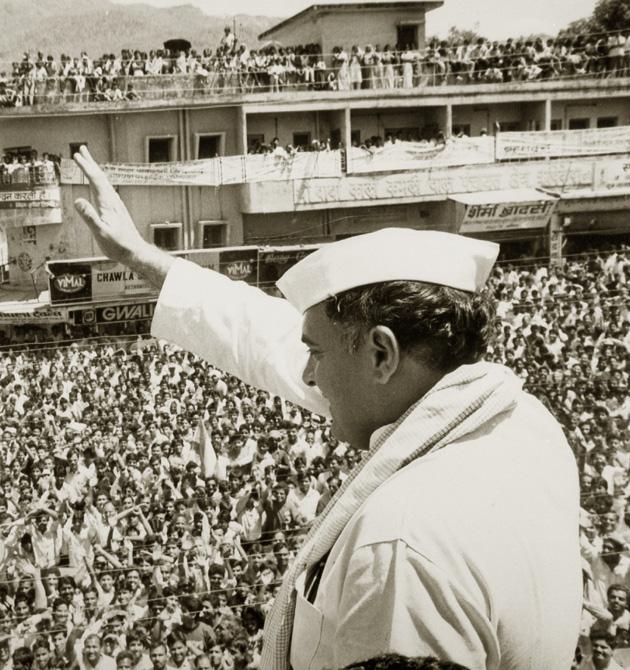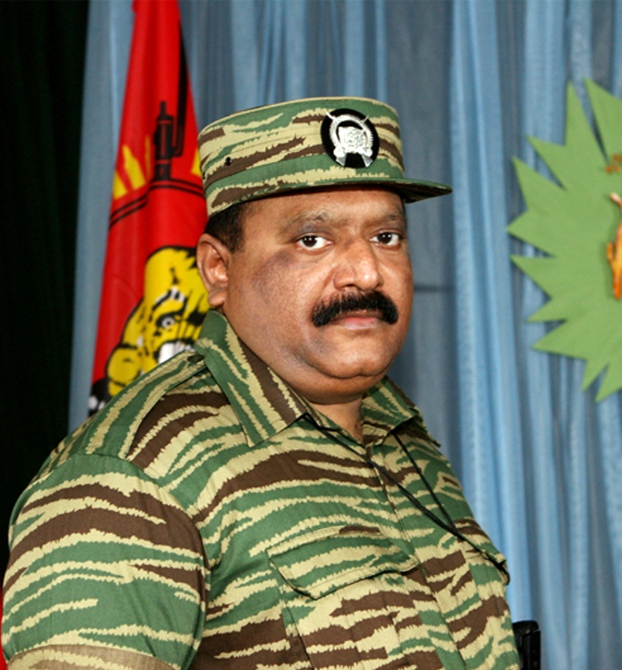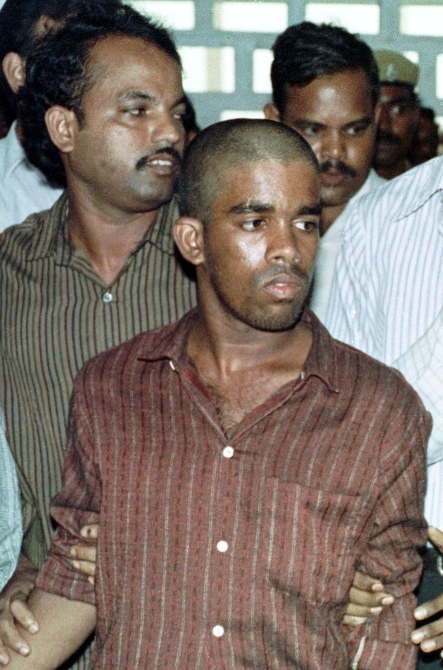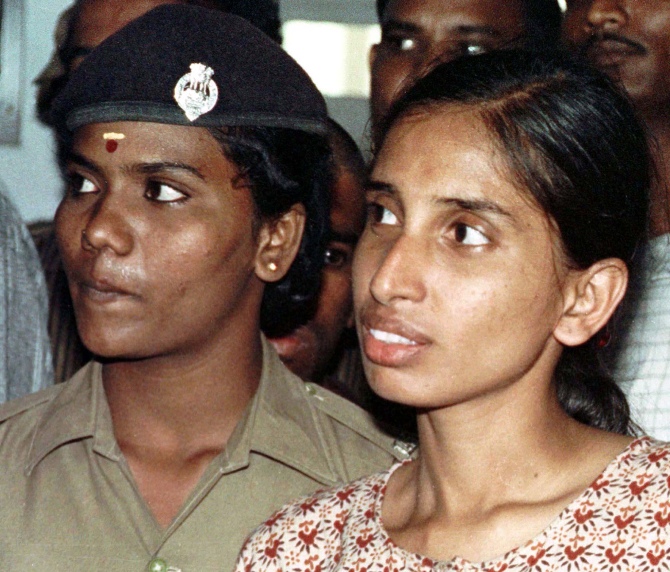Photographs: Reuters
The Rajiv Gandhi assassination shook the nation in May 1991 in the middle of a heated election campaign. Rediff.com brings you a chronology of the more than two decade-long case, which is in the news again after the Supreme Court stayed the execution of three of the accused in the case. The Tamil Nadu government now wants to free all the seven accused in the case, a move stalled by the SC on Thursday.
Twenty-four years after the assassination of former prime minister Rajiv Gandhi, the Supreme Court on Tuesday commuted the death sentences of three condemned prisoners to life imprisonment, on the ground of 11 years delay in deciding their mercy plea by the Centre.
Rajiv Gandhi was killed in May 1991. His assassins were convicted by a Terrorist and Disruptive Activities (Prevention) Act court in January 1998 and were awarded the death sentence, which was confirmed by the apex court May 11, 1999.
The SC bench said they are unable to accept the Centre's view and commuted the death sentence of convicts -- Santhan, Murugan and Perarivalan -- to imprisonment for life subject to remission by the government.
The Tamil Nadu government has given the Centre three days to give its decision on the release of the killers. After three days, the Jayalalithaa government will go ahead and release all the other convicts as well, who are undergoing life sentences. However, on Thursday the SC stayed the release of the three accused.
..
How it all started: The Sri Lanka conflict
Image: Tamil rebels keep watch during funeral procession of a slain commander at a Tamil rebel-controlled area in Batticaloa, eastern Sri Lanka in this photograph taken on May 24, 2006.Photographs: Buddhika Weerasinghe/Reuters
On July 29, 1987, then Indian prime minister Rajiv Gandhi and Sri Lankan President J R Jayawardene signed the Indo-Sri Lanka peace accord, expecting to resolve the then ongoing civil war in that country.
- Beginning on July 23, 1983, there had been intermittent insurgency against the Lankan government by the Liberation Tigers of Tamil Eelam, also known as the Tamil Tigers, a militant organisation which fought to create an independent Tamil state called Tamil Eelam in the north and the east of the island.
- The LTTE (and other Tamil groups) had not been made party to the talks and initially agreed to surrender their arms to the Indian Peace-Keeping Force only reluctantly, which initially oversaw a partial disarmament of the militant group.
- But just after a few months, the LTTE declared their intent to continue their armed struggle. In the ensuing months, the IPKF found itself engaged in bloody action against the militant group.
- Even as casualties mounted for the IPKF, Rajiv refused to recall the troops. But after his defeat in the 1989 polls, V P Singh, the new prime minister ordered their withdrawal, which was finally completed in 1990.
- The death toll was high for both the sides – approximately 1,200 for the IPKF, and around 5,000 on the Lankan side. The total cost of the effort for the Indian government? Approximately Rs 10 billion.
- LTTE chief V Prabhakaran, who had termed the IPKF as the ‘Satanic force’ feared that Rajiv Gandhi might re-induct the force in the region if he was re-elected in the 1991 general elections. And even before the National Front government in New Delhi finally collapsed, the LTTE had made up its mind to kill Rajiv.
...
How the assassination was carried out
Image: Former leader of the Liberation Tigers of Tamil Eelam Velupillai Prabhakaran.Photographs: Reuters
Realising that it would be near-impossible to kill Rajiv once he became prime minister, the LTTE decided to strike while his security status was still that of an opposition leader.
- Having finalised the decision to kill Rajiv, Prabhakaran summoned his four trusted lieutenants -- of which were Murugan and Shivarasan -- to finalise plot the assassination. Subramaniyam and Muthuraja were summoned from Madras (Chennai) where they were staying at that time.
- Murugan, a key instructor and an explosive expert of the LTTE, was asked to take over the assignments from Subramaniyam and Muthuraja after their departure for Jaffna. Shivarasan, later labeled the 'one-eyed-jack' was given the actual task of the assassination. The team swung into action to recruit participants for the plot.
- By February 1991, the recruitment was complete. The team now had some locals from Chennai, which included the electronics expert A G Perarivalan (who allegedly made the bomb vest but was kept away from the actual assassination plot), and Nalini, the two accused whose death sentence has been commuted to life sentence now.
- Shivarasan was meanwhile selecting his human bombs in Jaffna -- Dhanu and Shubha -- who happened to be his cousins.
- By mid-April, the weapon that would kill Rajiv and 16 others was ready to be put to use. The first dry-run took place on April 21, 1991 at the Marina Beach in Chennai.
- On May 12, 1991, the second dry-run took place, in a public meeting which had the then prime minister V P Singh and DMK leader M Karunanidhi. Interestingly, Dhanu was able to touch Singh’s feet, just as she would fatefully do to Rajiv Gandhi nine days later.
- On May 20, 1991, Shivarasan decided to strike at Sriperumbudur, the venue for Rajiv’s meeting.
- On May 21, 1991, Dhanu holding the garland, positioned herself around the VIP enclosure. Shubha and Nalini sat in the crowd. Shivarasan, acting as the back-up, carried a pistol, and took his position near the dais.
- Rajiv arrived at around 10 pm, and was surrounded by people trying to garland him. A policewoman tried to prevent Dhanu from getting close to Rajiv, but the latter said: "Let everybody get a chance."
- Dhanu bent down to touch Rajiv's feet and activated the bomb, killing Rajiv, and everyone in the blast radius.
...
The aftermath
Image: Sriharan alias Murugan seen in a court in Chengalpattu in this photograph taken onm June 15, 1991.Photographs: Reuters
May 22, 1991:
The state police registers a case and recovers the camera which filmed the assassination and other evidence from the scene. D R Karthikeyan, former special director of the Central Bureau of Investigation, visits the scene of blast.
May 24, 1991:
The CBI forms the Special Investigation Team. Karthikeyan takes over as the SIT chief. Judge S M Siddick appointed judge of the designated court to try the case.
May 25, 1991:
Sivarasan, stand-by assassin Subha, Nalini and two others visit Tirupati, worship and return the next day.
May 26, 1991:
Sivarasan packs up Subha to Pollachi. She returns to the city later.
June 14, 1991:
Nalini, the first accused, and her husband Murugan arrested.
June 28, 1991:
Sivarasan, Subha and others escape in an empty tanker from Chennai to Bangalore. They reach Bangalore the next day.
August 18, 1991:
The SIT traps Sivarasan and others in their Konanakunte hide-out in suburban Bangalore. Sivarasan kills himself and Subha and five others consume cyanide and die.
August 29, 1991:
Rangan, the last accused in the case, arrested.
May 20, 1992:
SIT files charge sheet before the designated court.
May 5, 1993:
Pre-trial begins in the high security prison at suburban Poonamallee.
November 24, 1993:
Charges framed against the accused.
The trial
Image: Nalini (right) seen in a court in Chengalpattu in this photograph taken on June 15,1991.Photographs: Reuters
In-camera trial and examination of witnesses begins on January 19, 1994.
May 29, 1994:
Prabhakaran, intelligence chief Pottu Amman and women's wing leader Akila declared as proclaimed offenders.
June 3, 1994:
The Indian government sends requisitions to Sri Lankan government seeking the trio's extradition.
June 21, 1997:
Questioning of the accused based on the deposition of the witnesses begins.
July 21, 1997:
Prosecution begins summing up of the case and ends it on August 11, 1997.
November 5, 1997:
The marathon trial ends. Judge reserves orders for January 28.
January 28, 1997:
Judge finds all 26 accused guilty, says LTTE was responsible for Rajiv's death.
September, 1998:
The Supreme Court starts hearing death appeals of all the 26 accused.
May 11, 1999:
The SC panel confirms the death sentence of Nalini, Santhan, Murugan and Perarivalan.
June 28, 2006:
LTTE accepts the responsibility of the assassination of Rajiv.
Subsequently, after a 26-year military campaign, the Sri Lankan military defeated the Tamil Tigers in May 2009, bringing the civil war to an end.
August 11, 2011:
Eleven years after the Supreme Court confirmed the death sentence of Murugan, Santhan and Perarivalan, the then President Pratibha Patil, rejects the mercy plea of the three death row convicts
August 30, 2011:
The Madras high court puts a stay order on the death sentence of the three convicts.
February 19, 2014:
Supreme Court commutes their death sentence to life imprisonment on the ground of 11 years delay in deciding their mercy plea by the Centre. The Tamil Nadu government wants to release all the convicts, who have spent 23 years in jail.
Febraury 20, 2014
SC stays the decision of the state government to release the convicts.
TOP photo features you missed last week
Photographs: Reuters
Click on MORE to see another PHOTO feature...






article